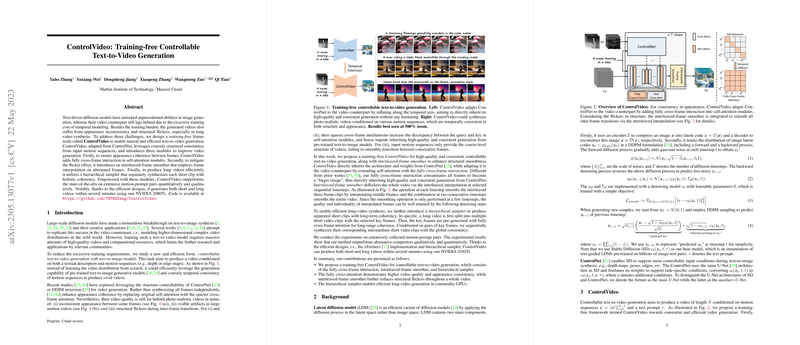ControlVideo: Training-free Controllable Text-to-Video Generation
The paper "ControlVideo: Training-free Controllable Text-to-Video Generation" presents a novel framework for generating videos from text prompts without requiring additional training. This approach addresses key challenges in text-driven video synthesis, including maintaining temporal consistency and reducing computational costs.
Key Contributions
ControlVideo distinguishes itself by integrating three primary components that enable efficient and high-quality video generation:
- Fully Cross-frame Interaction: The model is adapted from ControlNet by extending the self-attention mechanism along the temporal dimension. This fully cross-frame interaction treats the frames as a single "large image" which enhances appearance consistency between frames. The interaction is designed to minimize quality degradation by closely mirroring the generation capabilities of pre-trained text-to-image models.
- Interleaved-frame Smoother: To mitigate structural flickers across frames, ControlVideo introduces an interleaved-frame smoother. This mechanism interpolates alternate frames, creating a transition that reduces flicker without significant computational overhead. The smoother operates selectively at specific timesteps, refining the continuity of the entire video sequence.
- Hierarchical Sampler: For long video generation, a hierarchical sampler is employed, allowing the synthesis of long videos in segments. This sampler divides a long video into shorter clips, synthesizing them sequentially with a focus on maintaining global coherence. This enables the production of extended sequences using standard GPU resources.
Experimental Analysis
ControlVideo demonstrates superior performance compared to contemporary methods like Tune-A-Video and Text2Video-Zero. Quantitative evaluations performed on 125 motion-prompt pairs indicate that ControlVideo achieves higher frame consistency and better alignment with textual prompts. Additionally, user studies reveal a preference for videos generated by ControlVideo in terms of video quality and temporal consistency.
The framework efficiently generates both short and long videos within several minutes on a single NVIDIA 2080Ti, making it accessible for a broader range of users compared to models requiring significant computational resources.
Implications and Future Directions
ControlVideo offers meaningful advancements in the domain of text-to-video generation without the need for extensive video datasets or additional model training. This is a step forward in making AI-driven content creation more accessible and efficient. However, it remains limited by its strict reliance on input motion sequences, which constrains the creative potential of the generated videos.
Future research directions include developing methods to dynamically adapt motion sequences based on text prompts, thereby expanding the creative possibilities of video synthesis. Furthermore, addressing ethical considerations and preventing the misuse of such technologies will be critical as they become increasingly integrated into creative workflows.
Overall, ControlVideo represents a significant advancement in efficient video generation, offering both theoretical insights and practical applications in automated video content creation.
